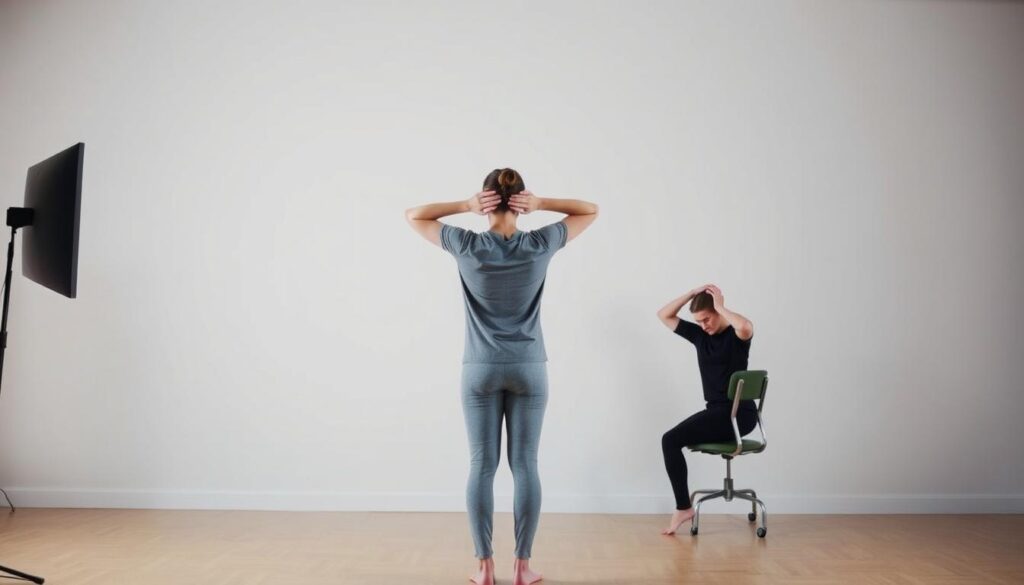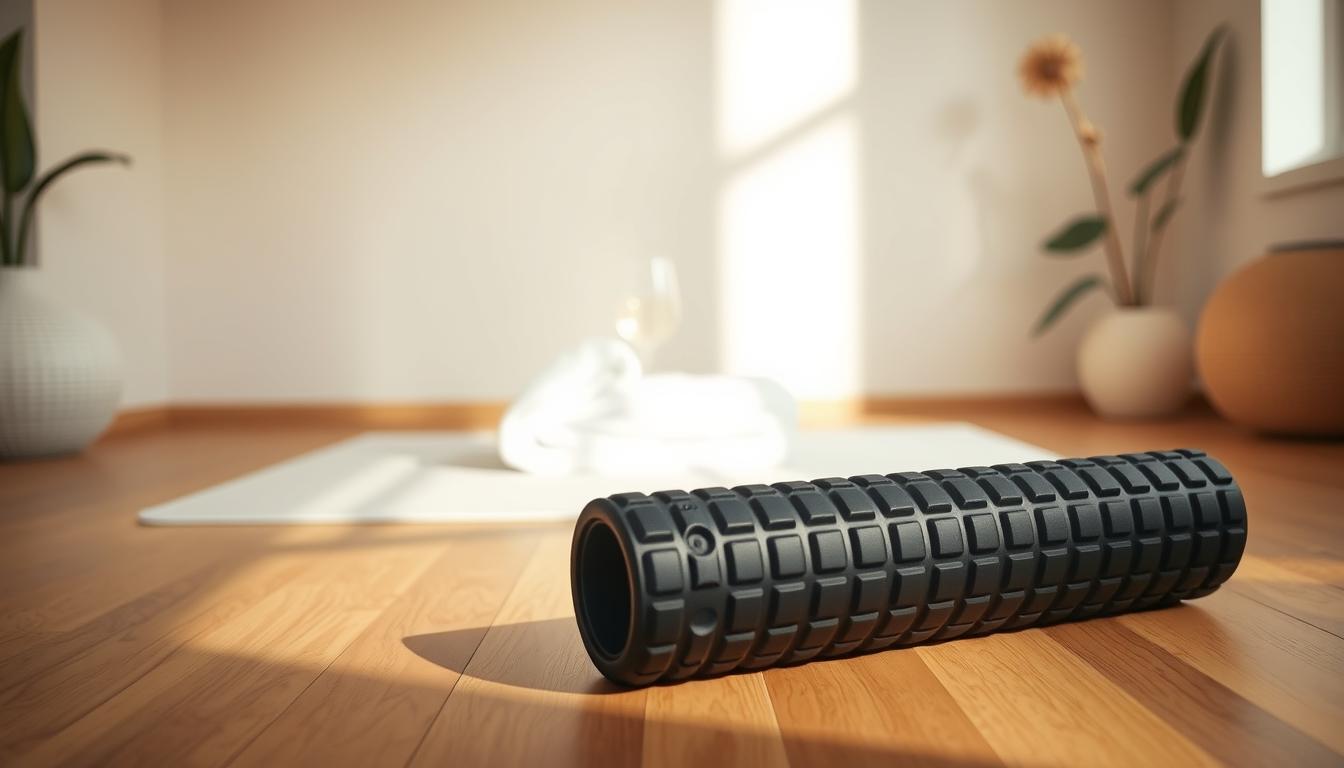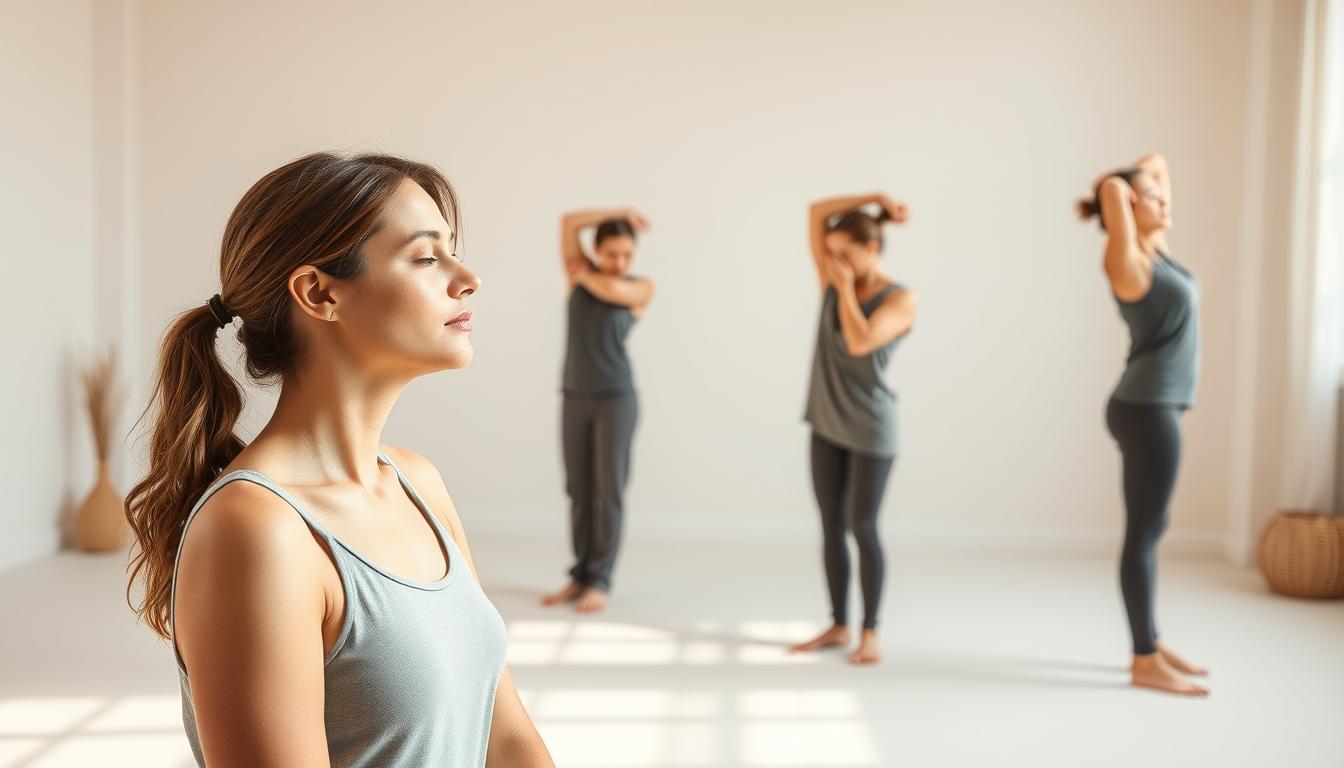In our busy work life, keeping a good posture is key for office workers. Being bent over computers for long hours causes many health problems, especially with the neck. Adding neck exercises to your daily schedule helps improve posture and boosts overall health at work.
When workers understand how crucial their neck health is, they do better in their job. They feel more comfortable and enjoy a better quality of life while working.
Introduction to Workplace Posture Challenges
Many people working in desk jobs face poor posture issues. Most of their day is spent sitting, leading to big problems. Sitting too much can cause discomfort and musculoskeletal disorders. This happens because of bad office setup and not knowing how to sit correctly during work.
About 8 in 10 American desk workers have trouble with their posture. This shows how important it is to focus on posture at work. By using the right strategies, office conditions can get better. It can help employees stay well and work better. Knowing how to maintain good posture is key to avoiding health problems from too much sitting.
Understanding the Importance of Neck Health
Neck health is crucial for feeling good overall. It helps us move our heads and keep our body straight. Good posture is very important, especially for people who sit a lot during the day. Sitting the wrong way can make your neck and shoulders hurt.
Knowing how to set up your workspace is key. It helps you sit and stand better. Taking breaks to stretch and doing exercises can prevent neck problems. These steps make your neck stronger and more flexible, making work better for your health.
Common Neck Issues Faced by Office Staff
Many office workers often face neck problems because of their job. Sitting for too long and doing the same movements over and over can cause a lot of discomfort. People usually feel stiff, tense, and have ongoing pain. These problems mostly come from bad sitting habits and using computers a lot, leading to something called tech neck.
Musculoskeletal disorders are common in people who work in offices. This is because of the repetitive strain from sitting all day. The upper trapezius muscle, located in the neck, is usually the one that gets hurt the most.
It’s important to take care of these neck issues early. Doing the right exercises and sitting properly can help a lot. If these problems aren’t handled early, they can lead to more serious health issues for office workers. So, it’s key to be aware and take action to keep your neck healthy.
Posture-Focused Neck Exercises for Office Staff
Maintaining good posture at your desk can be tough. It gets even more challenging for those working long hours in front of a screen. Adding simple neck exercises to your day can really help with comfort and flexibility. Here are three great neck exercises designed for office workers.
Chin to Chest Stretch
The chin to chest stretch is a basic but effective exercise. It eases tension in your neck and shoulders. Just lower your chin to your chest while keeping your back straight. Stay like this for 15 to 30 seconds. This stretch helps you relax and fight off stiffness. It’s a must-have in your desk exercise routine.
Side Neck Stretch
The side neck stretch works wonders for your neck’s side flexibility. Start by leaning your head toward your right shoulder. Hold that for 15 to 30 seconds, then do the same on your left side. This move helps relieve tightness and increases your neck’s mobility, essential for a healthy posture while working.
Neck Rotation Exercise
Neck rotation boosts your mobility with a simple twist. Turn your head to the right until you feel a stretch. Hold it, then switch to the left side. You can easily do it at your desk. It’s an ideal exercise to mix into your daily office life.
Benefits of Incorporating Neck Exercises
Neck exercises bring many advantages to people in an office. These activities improve how workers feel in general. They also enhance fitness, mental focus, and how much work gets done.
Improved Flexibility and Mobility
Neck stretches make you more flexible and mobile. Doing these stretches often makes your neck less stiff. This leads to moving easier and sitting up straighter at work.
Reduction of Pain and Discomfort
Neck exercises can really cut down on the pain office workers often feel. Sticking to a stretch routine might reduce pain by up to 72%. A more comfortable work setting boosts focus and job performance.
Stretching Techniques to Enhance Neck Flexibility
To improve neck flexibility, it’s key to use effective stretching methods. Specific stretches help reduce tension and increase relaxation. The upper trap stretch and the dorsal glide are great for office workers.
Upper Trap Stretch
The upper trap stretch eases tension in the trapezius muscles. Here’s how to do it:
- Gently pull your head towards your right shoulder.
- Hold this position for 15-30 seconds.
- Repeat on the left side.
This stretch helps make your neck more flexible. It releases tightness and discomfort.
Dorsal Glide Stretch
The dorsal glide stretch improves neck alignment and flexibility. To do this stretch:
- Tuck your chin towards your chest.
- Gently slide your head back, chin tucked.
- Hold for a few seconds, then ease back to start.
Using these stretches can make your neck more flexible. They also help with better posture at work.
Incorporating Exercises into Your Daily Routine
Adding regular neck exercises to your day can boost well-being and work productivity. Taking short breaks to do simple activities helps improve comfort and lessen stress. Using stretch reminders is a great way to make this a habit for a healthier office life.
Setting Reminders for Regular Stretching
To keep up with daily stretches, setting reminders is key. Here are ways to remember:
- Use smartphone apps that alert you to take stretching breaks.
- Set times to stretch during the day, like after tasks or in meetings.
- Put sticky notes as stretch reminders near your work area.
Quick Office-Friendly Neck Exercises
Easing neck exercises into your day can spike productivity. Try these simple neck stretches:
- Shoulder Shrugs: Lift your shoulders up to your ears, hold, then drop them.
- Seated Neck Rolls: Gently roll your neck in circles, switch directions after a few turns.
- Chin Tucks: Pull your chin down towards your chest, hold, then let go.
Creating a Supportive Work Environment
A well-designed workplace boosts employee comfort and work output. It uses ergonomic solutions and smart design to meet staff physical needs. Let’s look into key aspects that make work better for everyone.
Ergonomic Furniture Solutions
Ergonomic furniture is crucial for better posture and less discomfort at work. Adjustable chairs help support the back and allow for various sitting styles. Desks that adjust in height cater to everyone’s size and work preferences.
- Adjustable chairs that support lumbar alignment
- Height-adjustable desks for optimal working levels
- Supportive accessories like footrests and monitor stands
Utilizing Standing Desks
Standing desks let employees switch between sitting and standing, reducing discomfort and boosting energy and productivity. It’s a good idea for employees to find standing desk designs that fit their work needs.
- Encouragement to stand during meetings
- Integration of sit-stand desk converters
- Workstation designs that allow for easy transitions
Additional Exercises for Comprehensive Upper Body Relief
Making upper body relief exercises a part of your day can make your neck and shoulders healthier. These exercises help ease tension and make moving easier, fighting the downsides of sitting too much and bad posture.
Shoulder Shrugs
Shoulder shrugs are easy but really help relax your neck and shoulders. Here’s how to do them:
- Stand or sit straight.
- Lift your shoulders to your ears while you breathe in.
- Hold for a few moments.
- Lower your shoulders as you breathe out.
Regular shoulder shrugs can lessen pain and make your upper body feel better.
Upper Body Twists
Upper body twists work out your core and help your upper body move better. Here’s how to do this exercise:
- Sit straight, feet on the ground.
- Put your left hand on the back of your chair.
- Twist left, using your hand for help.
- Stay like that for a bit, then face front again.
- Do the same on your right side.
Adding upper body twists to your stretches can make you more flexible and improve your neck and shoulder health. They’re great for anyone who works at a desk.

Encouraging Workplace Wellness Culture
Building a strong workplace wellness culture improves employee health and happiness. It’s vital for companies to encourage staying active and to provide stretching programs designed for office life. This not only helps with physical health but makes the work environment positive and lively.
Promoting Physical Activity Among Employees
Getting employees to add physical activity to their day boosts morale and work output. A few easy steps are:
- Organizing group workouts during break times.
- Creating walking meetings to facilitate movement.
- Providing incentives for active participation in fitness challenges.
Implementing Stretching Programs in the Office
Stretching regularly is a great answer to the sitting-down culture of office jobs. Adding these programs shows a company cares about its employees’ health. You might offer:
- Guided stretching sessions led by wellness coordinators.
- Stretching reminders via company-wide communications.
- Resources such as posters or handouts detailing quick stretches.
Conclusion
Putting neck health first with good exercises makes the office nicer for everyone. Adding these exercises to daily work routines helps staff feel better and move easier. This simple change can make the workplace healthier, keeping everyone focused and doing their best all day.
Also, making wellness a big deal is key for a company’s success. When businesses support neck exercise programs, they show they care about their people. This leads to a stronger team that values health, benefiting everyone at work.
It’s time to take action on neck health. Doing these exercises can make a big difference for each person and the whole company. A workplace that puts health first is a happier place. That matches what modern businesses are aiming for.



